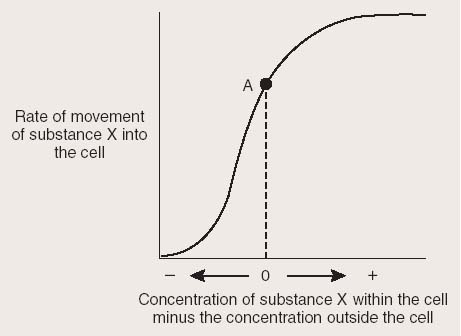 |
| 1 |  | 
Why does a surgeon irrigate a surgical wound from which a tumor has been removed with sterile distilled water rather than with sterile isotonic saline? |
|  | |
|
|
 |
| 2 |  | 
Solution A is hyper osmotic to solution B. If solution A is separated from solution B by a selectively permeable membrane, does water move from solution A into solution B or vice versa? Explain. |
|  | |
|
|
 |
| 3 |  | 
A researcher wants to determine the nature of the transport mechanism that moved substance X into a cell. She could measure the concentration of substance X in the extra cellular fluid and within the cell, as well as the rate of movement of substance X into the cell. She does a series of experiments and gathers the data shown in the graph. Choose the transport process that is consistent with the data.
- diffusion
- active transport
- facilitated diffusion
- not enough information to make a judgment
 <a onClick="window.open('/olcweb/cgi/pluginpop.cgi?it=jpg::::/sites/dl/free/0072507470/234417/eq_ch03_q3_fig01.jpg','popWin', 'width=NaN,height=NaN,resizable,scrollbars');" href="#"><img valign="absmiddle" height="16" width="16" border="0" src="/olcweb/styles/shared/linkicons/image.gif"> (28.0K)</a> <a onClick="window.open('/olcweb/cgi/pluginpop.cgi?it=jpg::::/sites/dl/free/0072507470/234417/eq_ch03_q3_fig01.jpg','popWin', 'width=NaN,height=NaN,resizable,scrollbars');" href="#"><img valign="absmiddle" height="16" width="16" border="0" src="/olcweb/styles/shared/linkicons/image.gif"> (28.0K)</a>
Graph depicting the rate of movement of substance X from a fluid into a cell (y axis) versus the concentration of substance X within the cell minus the concentration outside the cell (x axis). At point A the extra cellular concentration of substance X is equal to the intracellular concentration of substance X (designated 0 on the x axis). |
|  | |
|
|
 |
| 4 |  | 
A dialysis membrane is selectively permeable, and substances smaller than proteins are able to pass through it. If you wanted to use a dialysis machine to remove only urea (a small molecule) from blood, what could you use for the dialysis fluid?
- a solution that is isotonic and contains only large molecules, such as protein
- a solution that is isotonic and contains the same concentration of all substances except that it has no urea
- distilled water, which contains no ions or dissolved molecules
- blood, which is isotonic and contains the same concentration of all substances, including urea
|
|  | |
|
|
 |
| 5 |  | 
Predict the consequence of a reduced intracellular K+ concentration on the resting membrane potential. |
|  | |
|
|
 |
| 6 |  | 
If you had the ability to inhibit mRNA synthesis with a drug, explain how you could distinguish between proteins released from secretory vesicles in which they had been stored and proteins released from cells in which they have been newly synthesized. |
|  | |
|
|
 |
| 7 |  | 
Given the following data from electron micrographs of a cell, predict the major function of the cell:
- moderate number of mitochondria;
- well-developed rough endoplasmic reticulum;
- moderate number of lysosomes;
- well-developed Golgi apparatus;
- dense nuclear chromatin;
- numerous vesicles.
|
|  | |
|
|

